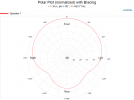View attachment 373239View attachment 373240
In the absence of bracing, the off-axis response does not show uniform attenuation, as illustrated in the graph above.
On the other hand, when bracing is present, these issues disappear, as shown in the graph below.
View attachment 373241View attachment 373242
The frequency range where problems occur is also visible in the contour plot, as seen below.
View attachment 373243View attachment 373244
When bracing is present, these issues do not appear in the specified range.
View attachment 373245View attachment 373246
Also, this can be easily observed in the polar plot.
Without bracing, a dip occurs at 553Hz, showing attenuation of sound on-axis, with strong sound occurring on the sides where resonance happens.
Similarly, at 465Hz, where a peak is observed, the opposite issue is evident.
View attachment 373247View attachment 373248
When bracing is present, the graph for 465Hz and 553Hz shows a stable response, as seen below.
View attachment 373250View attachment 373251
